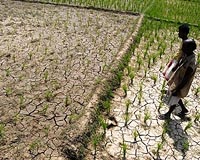| . |  |
. |
New Delhi (AFP) Sept 30, 2009 India has suffered its worst drought since 1972, the official weather office said on Wednesday, with rains 23 percent below average at the end of the country's four-month monsoon season. "India's 2009 monsoon rainfall has been the worst since 1972," a spokesperson for the Meteorological Department, P.K. Bandhopadhyay, told AFP. In 1972, monsoon rainfall was 24 percent below average, he said, while other bad years such as 2002, 1987 and 1979 had a 19-percent shortfall. "Officially, the four-month monsoon season is over," he said. "This year India has received a very bad monsoon." The impact of the drought varies according to region, with the southern peninsula recording minus seven percent while the northwest reported a deficit of 36 percent. Low rains have already ravaged India's rice, cane sugar and groundnut crops, and have disrupted the flow of water into the main reservoirs that are vital for hydropower generation and winter irrigation. Food prices for basics such as sugar have shot up in the country as a result of the lower farm yields and the rain shortage is also expected to hit India's economic growth this year. Over 70 percent of Indians depend on farm incomes, and about 65 percent of India's farms are unirrigated and depend on rains that fall between June and September, according to agricultural ministry figures. Indian Prime Minister Manmohan Singh said last month the country faced a severe drought, but that ample food stocks would be enough to ensure no one went hungry. Commodity experts say India's food stocks are enough to feed the poor who would be eligible for state support for three months. Estimates suggest that rice output will be about 10 million tonnes less than average and other agriculture commodities will be down 15 million tonnes in 2009, said food policy analyst Devinder Sharma. But India has 19 million tonnes of rice and 33 million tonnes of wheat as buffer stock. "There is a shortfall (in rain) but there is no cause for concern," Sharma said, adding that speculation and hoarding were also pushing up prices. He also suggested India should cease exports of agricultural commodities, particularly rice. India has received 679.3 millimetres of rainfall on average during the monsoon season in 2009, less than the 884.1 millimetres in a normal year, weather office data showed. The 1972 drought led to massive shortage of foodgrains and prices of all commodities rocketed, forcing the government to increase imports. Sangita Sharma, a senior member of the Forum for Biotechnology and Food Security, a non-government organisation that works with farmers, said the state was partly to blame for the hardship faced by farmers. "They (farmers) were not updated regularly about the failing monsoon and seeds were not distributed in a timely manner," she told AFP. "Farming is India's backbone but the government's faulty approach, (and) rampant black marketing has hit farmers and the final consumers." Share This Article With Planet Earth
Related Links Climate Science News - Modeling, Mitigation Adaptation
 India heading for worst drought since 1972: weather data
India heading for worst drought since 1972: weather dataNew Delhi (AFP) Sept 23, 2009 India's monsoon was about 20 percent below strength just over a week before the official end of the rainy reason, putting the country on course for its worst drought since 1972, weather data showed Wednesday. "Until September 21, for the country as a whole, the rain deficiency was 22 percent," said B.K. Bandopadhyay, a spokesman for the weather office. "We expect the total rain ... read more |
|
| The content herein, unless otherwise known to be public domain, are Copyright 1995-2009 - SpaceDaily. AFP and UPI Wire Stories are copyright Agence France-Presse and United Press International. ESA Portal Reports are copyright European Space Agency. All NASA sourced material is public domain. Additional copyrights may apply in whole or part to other bona fide parties. Advertising does not imply endorsement,agreement or approval of any opinions, statements or information provided by SpaceDaily on any Web page published or hosted by SpaceDaily. Privacy Statement |